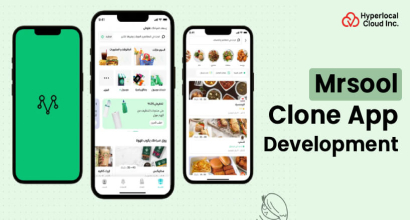Today, urban transportation is growing rapidly, and apps like Lyft are giving startups, fleet managers, and entrepreneurs opportunities to thrive in the industry. This innovative mobile app solution provides them with numerous advanced features to streamline ride-hailing operations and boost efficiency. If you are thinking of building an app like this, then this blog is for you. It explains everything about Lyft clone app development, with features, costs, and more.
Brief Overview of Lyft Clone App
A Lyft Clone App is a ride-hailing mobile application designed to mimic Lyft’s core features. It enables users to book rides, track drivers in real-time, and make cashless payments. Drivers can accept ride requests, navigate routes, and manage earnings. The app includes user registration, driver profiles, fare calculation, and ratings. Built with scalable technology, it aims to provide a seamless, convenient transportation experience similar to Lyft’s service.
Need help launching your Lyft clone?
Explore the Workflow of Lyft Clone App
We built a Lyft clone app that provides a seamless workflow to provide convenience and speed to users and profitability to the business owner.
Registration and Login
In the first step, riders and drivers sign up for the application by entering their mobile numbers, emails, or social accounts. On the other hand, drivers upload necessary documents, such as their license, ID, and vehicle papers, which are then approved by the admin.
Ride Booking
Later, riders enter their pickup and drop-off locations. The system shows fare estimates for ride options like standard, pool, and premium, with proper ETA before confirmation.
Driver Matching
Here, the app locates and shows nearby drivers to riders using GPS technology. Once a driver accepts, the rider gets notified with vehicle details and estimated arrival time.
Trip Start and Navigation
After pickup, the trip begins. Navigation support helps the driver follow the optimal route. The rider can track the journey in real-time.
Payment Processing
Once the trip ends, the rider can pay for the ride using their preferred payment method, whether wallet, card, or UPI. The system also generates detailed invoices, which are helpful for further records.
Ratings and Feedback
After that, the app provides a feedback system where riders and drivers rate each other. These ratings help the admin maintain service quality and trustworthiness.
Admin Oversight
The admin monitors everything from trip requests and earnings to dispute resolution, ensuring smooth operations and data control.
Boost Growth With Compelling Perks of Lyft Like App Development
It hardly matters whether you are targeting a local city or want to expand your services globally; investing in a Lyft clone app offers multiple advantages.
Quick Deployment
A Lyft Clone app eliminates the entire development process, which reduces the overall timings, and lets developers deploy it quickly in the market.
Custom Branding and Localization
A Lyft clone app development provides the admin with the advantage of customizing the solution in depth. They can change everything, starting from logos and themes to currency, language, and ride options to fit their target market.
Multiple Revenue Streams
Various entrepreneurs create a Lyft Clone to earn immense revenue through multiple ways, such as commissions, subscription plans, surge pricing, and even in-app ads.
Lower Operational Overhead
We built a robust ride-hailing app like Lyft that automates various admin operations. It automates the dispatch process, GPS tracking, and data management. This advancement reduces manual efforts and, in turn, results in lower operational and labour costs.
Real-Time Analytics
The system also tracks various business operations, including user behaviour, ride frequency, and regional demand patterns. It later provides detailed reports that the admin can use to make smarter decisions.
Includes Various Loyalty Tools
The app offers several loyalty points and promo codes, and lets riders view history, improve retention and user satisfaction.
Scalability
As the business expands towards new cities, the data details also increase. Therefore, we built an efficient Lyft clone with robust cloud computing to make it a scalable solution.
Key Features of Lyft Clone App
Discover the Comprehensive Feature Suite of Lyft Clone App
For Riders
1. Quick Ride Booking
Riders can book a ride instantly by entering pickup and drop-off locations. The app shows nearby drivers and estimated arrival times.
2. Fare Estimate
Before confirming a ride, users get an estimated fare range. This helps them plan and choose according to their budget.
3. Real-Time Ride Tracking
Users can track their driver’s location live on the map. It shows their route and estimated arrival in real time.
4. Multiple Ride Options
Riders can choose between standard, shared, or luxury rides. This gives flexibility based on comfort and price preferences.
5. In-App Payments
Users can pay directly through the app using cards, digital wallets, or coupons. It makes transactions smooth and cashless.
6. Trip History
Passengers can view past ride details, fare, and receipts. It’s useful for expense tracking or rebooking similar routes.
7. In-App Chat & Call
Riders can contact the driver via call or chat within the app. This helps in coordination without sharing personal numbers.
8. Ride Scheduling
Users can book rides in advance by setting the date and time. It ensures timely pickup for planned trips or meetings.
9. Rating & Review System
After each ride, passengers can rate the driver and give feedback. It helps improve service quality and rider safety.
10. SOS & Safety Tools
Emergency features like SOS button and ride-sharing with contacts ensure safety. Riders feel more secure during their journey.
For Drivers
1. Ride Request Notifications
Drivers get notified of nearby ride requests. They can accept or reject based on convenience and availability.
2. Earnings Dashboard
A built-in dashboard displays daily, weekly, and monthly earnings. It helps drivers track income and plan work better.
3. In-App Navigation
Lyft integrates with GPS to offer turn-by-turn navigation. This ensures timely pickups and accurate drop-offs.
4. Work Schedule Flexibility
Drivers can go online or offline anytime. They have full control over when and how long they want to work.
5. Trip History & Reports
Drivers can view details of completed trips and ratings. This helps track performance and manage records.
6. Incentives & Bonuses
Lyft offers extra earnings through promotions and peak-hour bonuses. This motivates drivers to work during high-demand times.
7. Ratings & Feedback System
Drivers receive ratings and feedback from riders. It helps maintain quality and improve customer experience.
8. Driver Support
In-app help and customer support are available 24/7. Drivers can report issues, get help with payments, or resolve disputes.
9. Driver Profile Management
Drivers can manage their profiles, update documents, and vehicle info. It helps maintain a professional and verified identity.
10. Fuel & Maintenance Discounts
Partner benefits like discounts on gas or repairs are offered. This reduces operational costs for drivers.
For Admin Panel
1. User Management Panel
Admins can manage all users, riders, and drivers from a single dashboard. It includes registration, verification, and status monitoring.
2. Ride Monitoring
Live tracking of all ongoing rides ensures control. Admins can see routes, status, and locations in real-time.
3. Fare & Commission Settings
Admins can set base fares, surge pricing, and commissions. It helps maintain balanced revenue models and driver payouts.
4. Report & Analytics Dashboard
Comprehensive reports on rides, revenue, ratings, and more. It supports data-driven decisions and operational optimization.
5. Dispute Resolution Tools
Admins can handle complaints from riders or drivers. This includes refunds, warnings, and account reviews.
6. Promo Code Management
Admins can create and manage discounts, offers, and referral codes. It helps in attracting new users and retaining current ones.
7. Driver Onboarding & Verification
Admins handle background checks, document uploads, and approvals. This ensures safety and compliance with local laws.
8. Automated Notifications
Push notifications, emails, and SMS alerts are configured from the admin side. It keeps users informed and engaged.
9. Zone & Geo-Fencing Management
Admins can create service zones, set surge pricing areas, and limit operations. It helps with resource distribution and control.
10. Third-Party Integration Control
Admins can integrate tools like payment gateways, analytics, or CRM. It enhances platform capabilities and service scalability.
Kickstart your ride-hailing business with our ultimate Lyft clone blueprint!
Top Tech Integrations in Lyft Clone App Development
The following are the top technologies we integrate in the Lyft clone app to improve the users’ experience.
1. Internet of Things (IoT)
IoT, also known as the Internet of Things, is the first technology we integrate into our Lyft clone app solution. Here, the professional developers connect the app with the vehicle sensors that provide real-time information about fuel used, engine performance, and GPS location. It also helps the admin to check the driver's behavior and predict any problematic areas in advance so they can make timely decisions.
2. Artificial Intelligence Technology
Next, the most common yet crucial technology we utilize is Artificial Intelligence. Its advanced Natural Learning Program provides an innovative chatbot that helps users find answers to their queries. It understands their inputs and provides accurate responses that improve their experience. In addition to this, the robust Machine Learning Algorithms predict the busy hours, traffic areas, and user preferences to help them find the accurate drivers.
3. Cloud Computing
It doesn't matter much whether you are handling 100 or 1 lakh users' data; utilizing cloud computing technology is a must for it. It saves all the crucial details safely and in an organized format to prevent data loss during any accidents. Also, this technology provides facilities like real-time backup and easy integration with third-party services to improve functionality.
4. Voice Hover Integrations
We all agree that driving is a critical job where the driver has to coordinate between multiple tasks. They have to focus with full attention while handling accelerators, brakes, and other road users. Therefore, we integrate the voice-over feature while developing the Lyft clone app. It allows them to manage multiple tasks at once. They can easily handle bookings, rescheduling, or canceling rides. In addition to this, it also provides convenience to visually impaired or disabled users while enhancing safety.
5. Facial Recognition Login
Finally, Facial recognition is another technology we add to build an app like Lyft. It enables both riders and drivers to log in using face identity to prevent fake registrations or entry of unauthorized access, increasing security.
Steps Required to Develop a Ride-Hailing App Like Lyft
These are the elaboration of the steps required to develop a ride-hailing app like Lyft. Check these steps once.
Market Research
Before entering into the development process, it is vital for every business owner to conduct in-depth research. First, check who your target audience is, and understand what their requirements are. Later, refer to the top research sites to study the rising trends in the transportation industry. Also, check the other existing competitors of the Lyft app, such as Bolt, Uber, etc. Find what unique services they are offering that you can add to your clone app.
Define Business Model
Decide what business model you want to set for your ride-hailing business. If you want to have an aggregator model where multiple drivers can register, start a self-owned fleet to manage and operate their own vehicle fleet. It is crucial to decide the correct business model as it influences the app’s features, revenue model, and benefits.
Select Core Features
Next, partner with the development team to decide what core features you want to integrate into the Lyft clone app. Also, this professional team of developers understands what your business requirements are and selects a reliable tech stack based on them. Later, they also make sure that the tech stack includes all the highly efficient technologies to build a robust, feature-rich, and scalable ride-sharing app like Lyft.
Plan UI/UX Design
In this step, the creative team of designers works together to create an attractive interface that grabs users’ attention. They incorporate multiple animations, graphics, and precise icon placement. Also, they add a consistent colour palette and typography that matches their business niche. In short, the team ensures that the app has an easy-to-use interface that provides users with a smoother navigation experience.
Development Phase
Coming to the development phase, developers utilize the highly efficient tech stack to build robust front-end and back-end. They use programming languages such as CSS, Java for front-end, and Node.js and React Native for backend development. They also implement security measures to ensure the solution is protected from unauthorized access and in compliance with the required or necessary regulations.
Integrate Third-Party Services
Besides offering the basic features, you can also ask developers to integrate third-party services to enhance its overall functionality. They can integrate the below-mentioned APIs to add new features. For example, Mapbox and Google Maps API for real-time navigation and Twilio for communication.
Complete Testing Phase
The testing phase is one of the most critical steps, where the Q&A team tests the app based on multiple factors. They make sure the app's functions are operating smoothly, secure, and scalable for future growth.
Launching & Marketing
Lastly, the development team deployed the application on the dedicated platforms, namely, on the Google Play Store and the Apple App Store. Later, they monitor if it's running smoothly on multiple devices without any glitches or errors.
Tech Stack, We Utilize to Build an Efficient Ride-Hailing App Like Lyft
The table below illustrates the most reliable functionalities utilized to build a ride-hailing app like Lyft.
| Type | Technology | Benefit |
| Frontend | React Native / Flutter | Cross-platform development with reusable code |
| Backend | Node.js / Laravel | Handles high concurrency and server-side logic |
| Database | MongoDB / PostgreSQL | Reliable storage for dynamic and static data |
| Payments | Stripe / Razorpay / PayPal | Supports secure and seamless financial transactions |
| Geolocation | Google Maps API / Mapbox | Provides accurate tracking and location-based services |
| Cloud Hosting | AWS / Google Cloud | Enables scalability and real-time data synchronization |
| Push Notifications | Firebase / OneSignal | Keeps users updated with alerts and promotions |
| Analytics | Mixpanel / Firebase Crashlytics | Tracks app performance and user behavior |
Revenue Model of Lyft Clone App
These are the various smart monetization strategies of a ride-sharing app like Lyft.
Freemium Model
Here, the admin provides basic features for free, while asking for certain charges to access premium rides or services offered by the app.
Subscription Plans
In this revenue model, the admin offers different subscription packages with various features. Drivers or corporate riders can pay to have access to these exclusive features.
Commission Charges
Build an app like Lyft and deduct a fee from every transaction completed by the driver or rider.
Cancellation Charges
The admin can charge a ride cancellation fee to riders or drivers as a penalty.
Surge Pricing
The advanced AI algorithms predict the peak hours or bad weather-like conditions, helping the admin to adjust pricing accordingly and earn more profit.
In-App Advertisements
Here, the admin partners with third-party businesses, displays their services within the app, and earns revenue.
Ready to build your own Lyft clone?
Discover Other Ride Sharing Clone Apps We Offer
Besides Lyft clone app development, at Hyperlocal Cloud, we offer various other scalable ride-sharing apps. Check the following clone apps we offer.
Creem Clone
We built a Creem Clone App that helps users book taxis in real-time, just like Creem in the Middle East. We include features for local currency support, multilingual features, and regional ride preferences to streamline the user experience.
Uber Clone
An Uber Clone App offers on-demand ride-hailing services with features like fare estimation, driver tracking, and digital payments. It's built to serve global or local markets like the Uber model.
Turo Clone
Our professional developers also built a Turo Clone App, a peer-to-peer car rental solution that allows users to rent cars directly from car owners, rather than booking rides.
Grab Clone
We offer a Grab Clone App that provides ride-sharing, food delivery, and parcel delivery services. Built with intuitive features and robust technologies to streamline the user experience.
Cabify Clone
Lastly, we offer a Cabify Clone that helps users book private or corporate rides with scheduled pickups.
Cost Breakdown to Build Ride-Hailing App Lyft
The estimated cost required to build a ride-hailing app like Lyft is $5,000. However, the following factors affect the overall price. Let us consider these pointers once!
Development Approach
This is a clear fact that developing an app from scratch requires more time and effort, which increases its overall cost. However, if you build a Lyft clone app, it reduces the long development process and time, which in turn reduces its cost compared to a custom.
Features Complexity
If you wish to integrate basic features, it doesn’t cost you much. However, incorporating advanced technologies for improved functionalities increases the overall costs.
Development Team
Next, hiring a professional development team that is skilled in their profiles may cost more, but the results are worth it.
UI/UX Design
A simple front end doesn't cost much, but creating a beautiful interface with multiple animations or graphics requires more development time and so has more cost.
Tech Stack
Choosing a robust tech stack with advanced technologies may require varying license costs, which increases the development cost.
Platform
Next, is the platform where you choose to deploy your clone app solution. Launching a Lyft-like app on a single platform doesn’t cost much more than on multiple ones.
Maintenance
Lastly, the development team charges a fee for offering post-deployment services like error mitigation, server upgrades, and feature additions.
Why Choose Hyperlocal Cloud for Lyft Clone App Development?
Hyperlocal Cloud Inc. is a top-notch ride sharing app development company. We have a successful record of offering totally robust, feature-rich, and scalable mobile app and software solutions. Our professional developers are highly skilled in developing efficient solutions that help you thrive in the competitive market. For further details, feel free to reach out our team!



